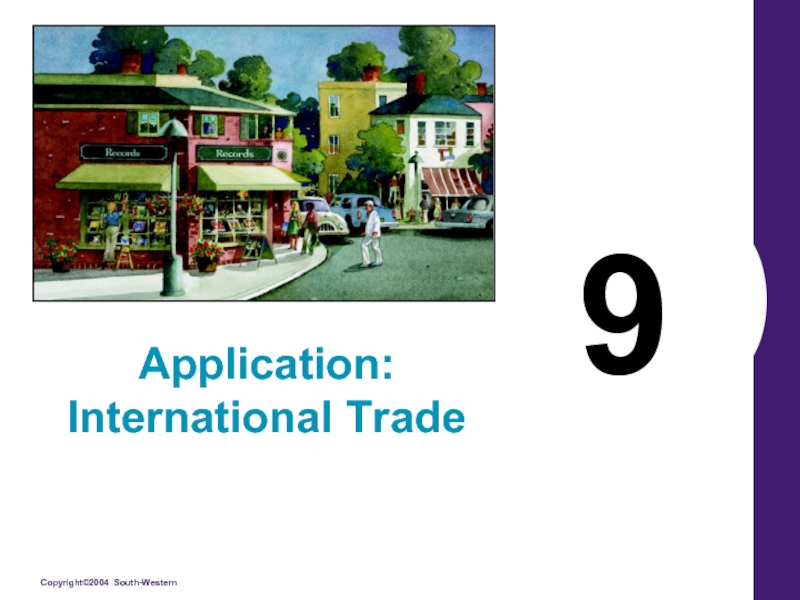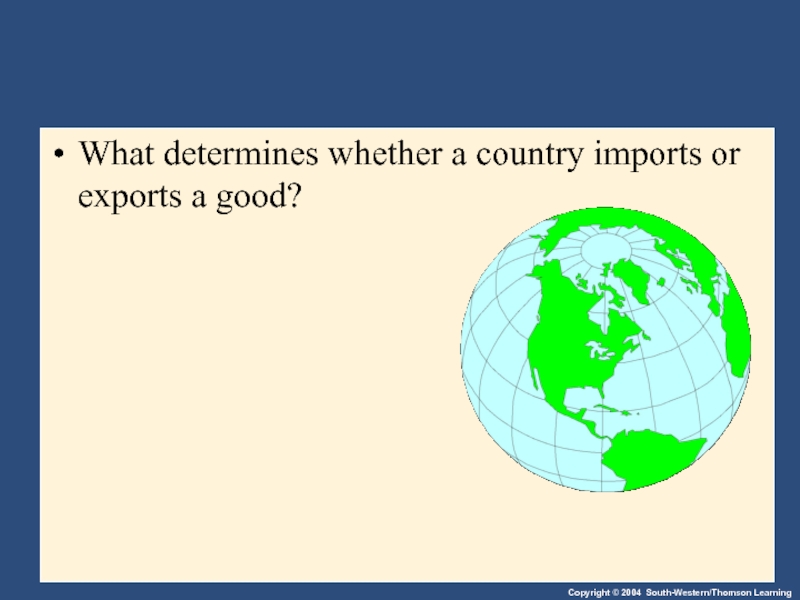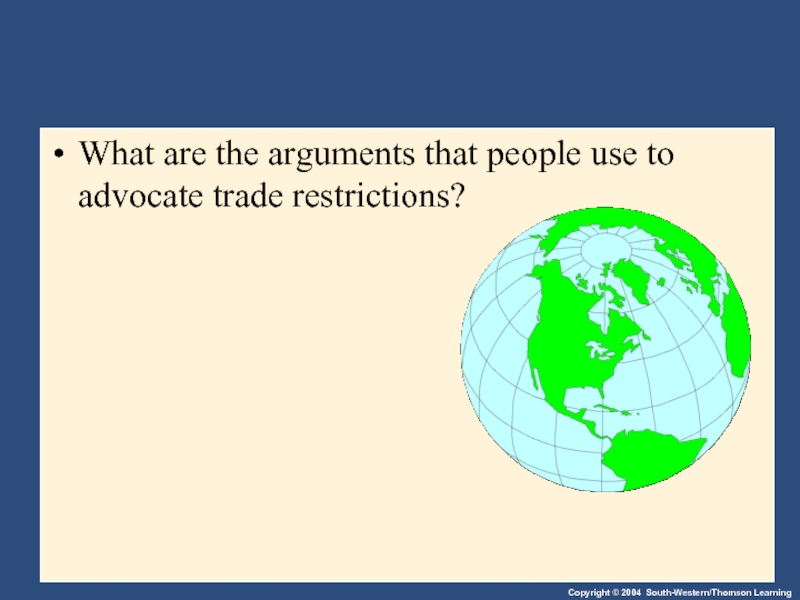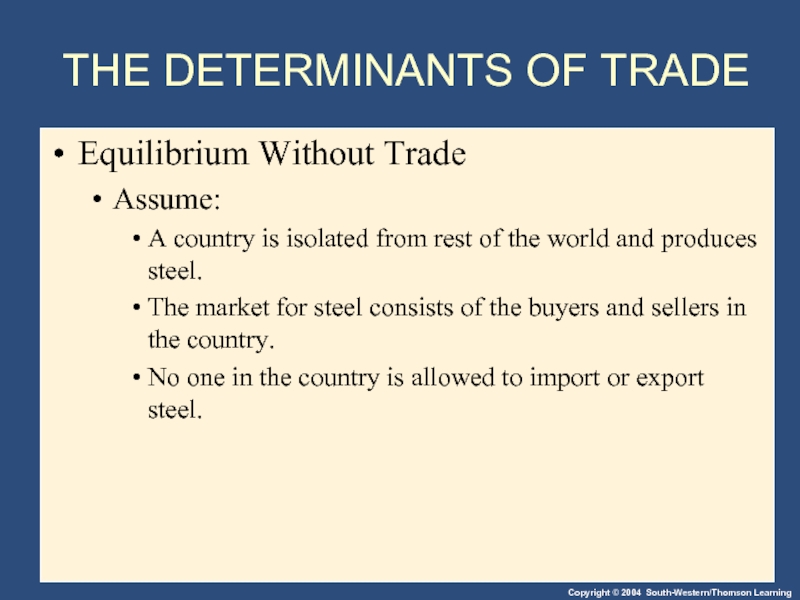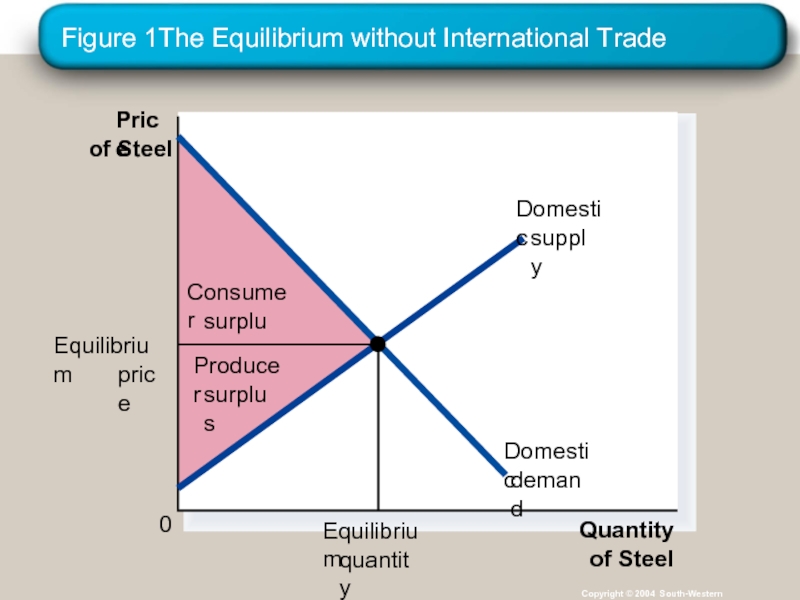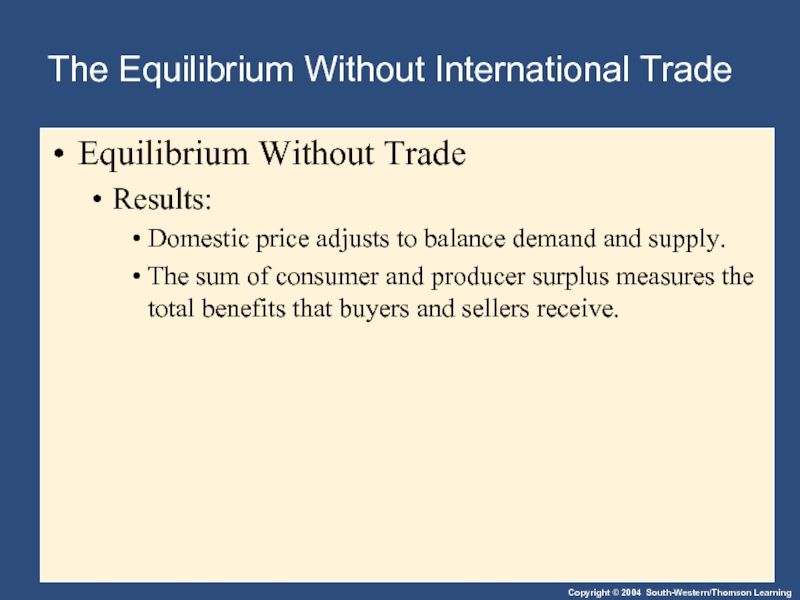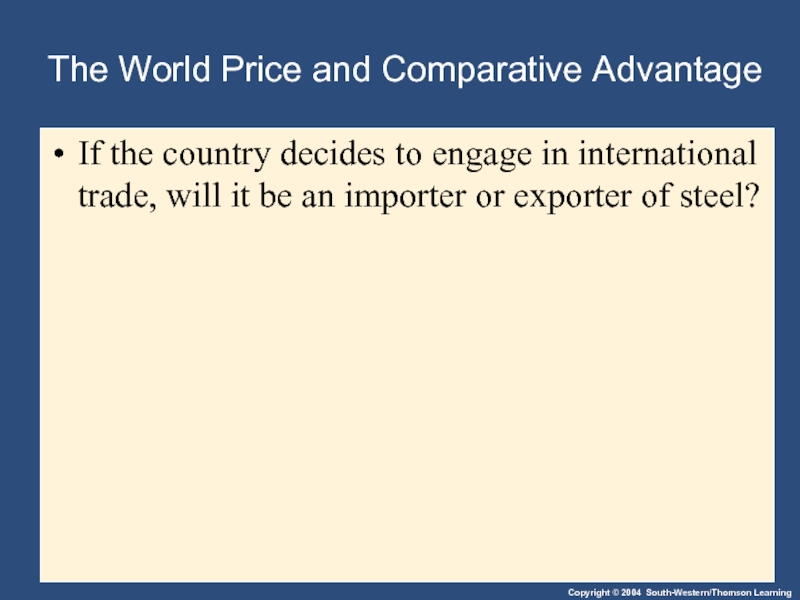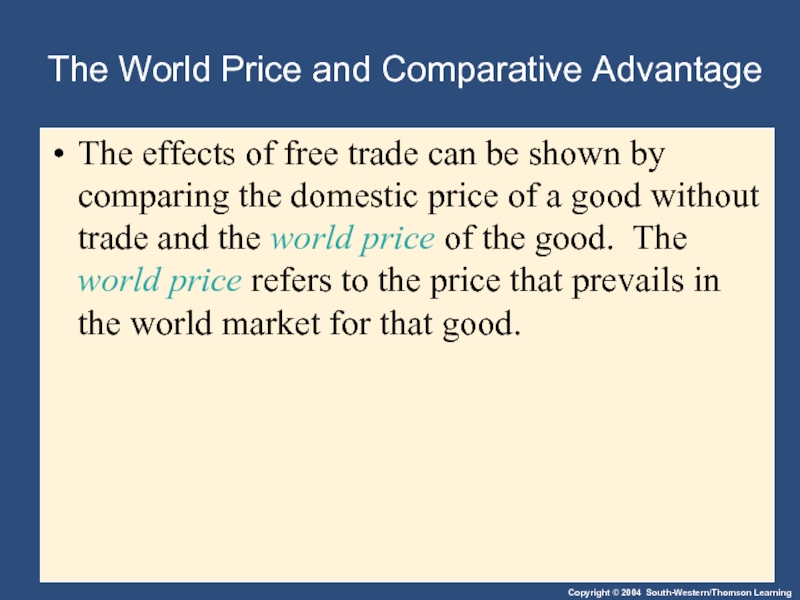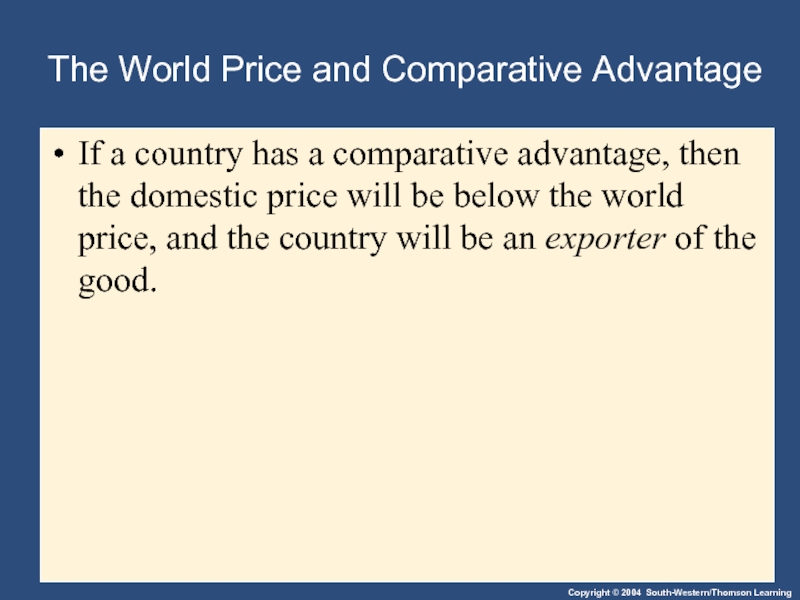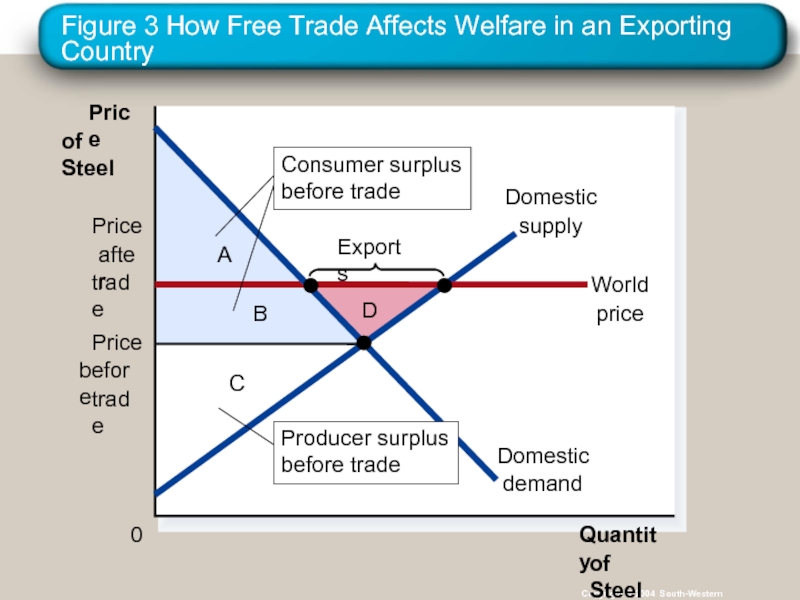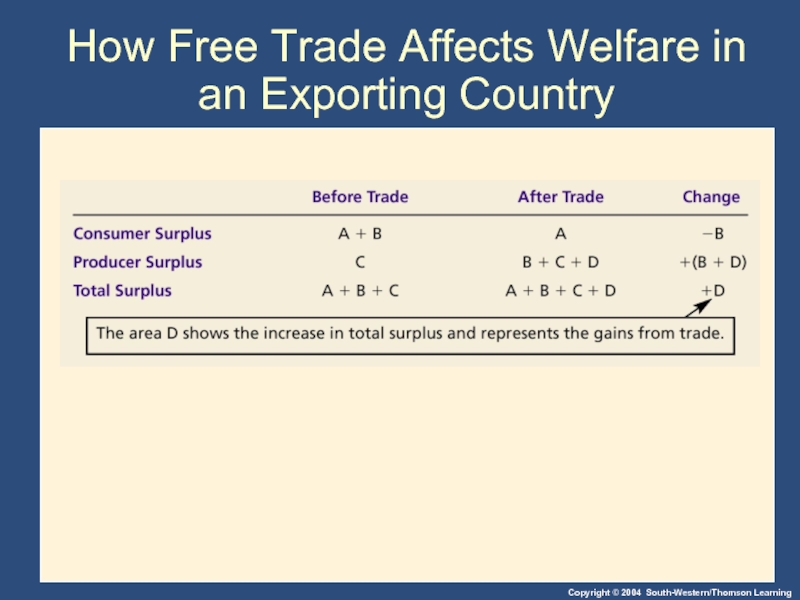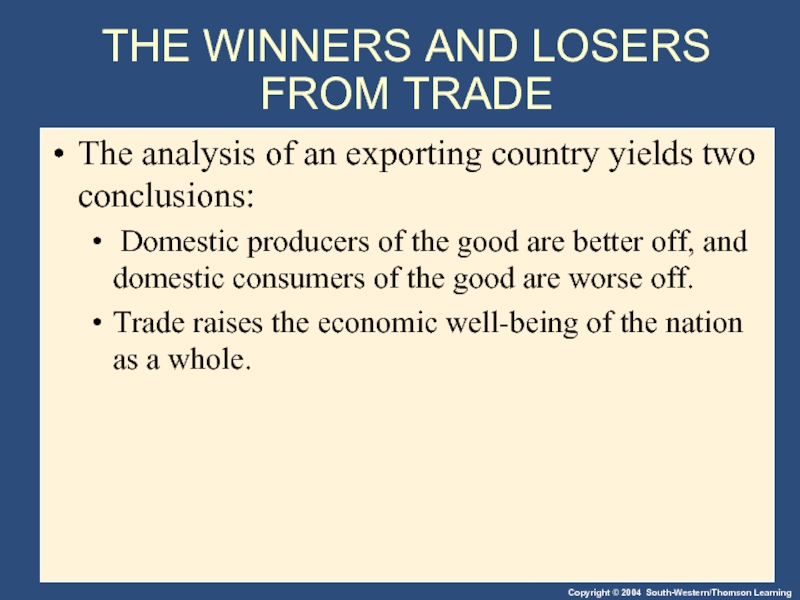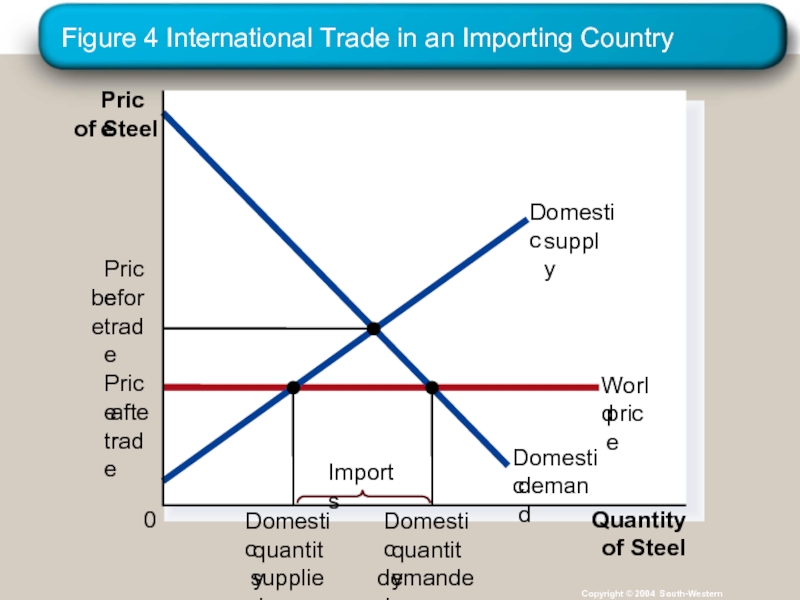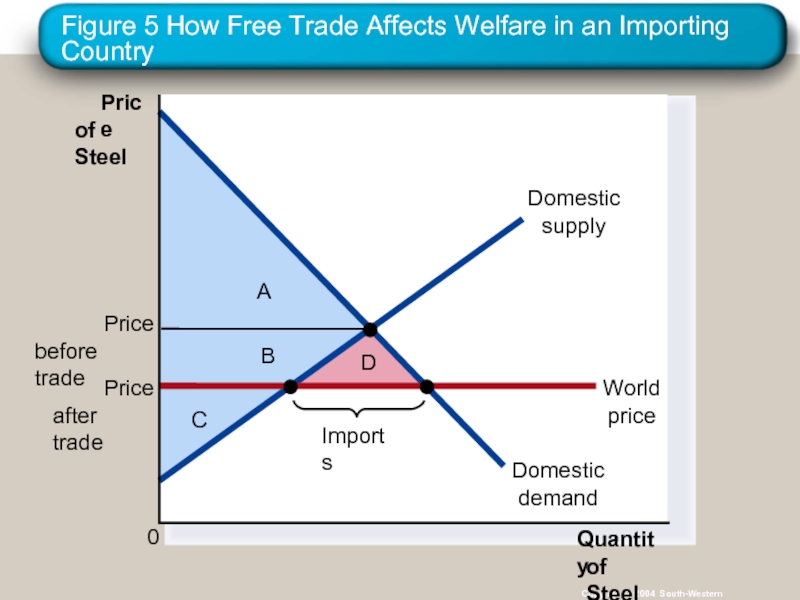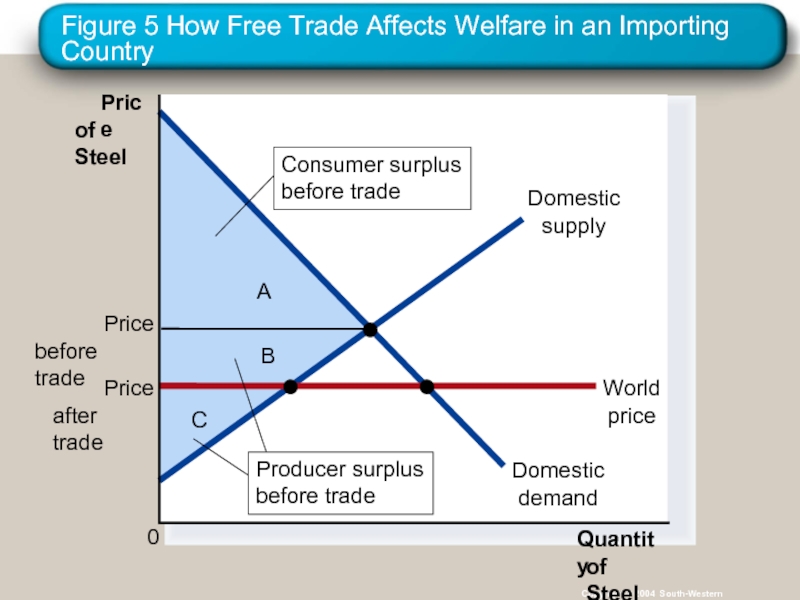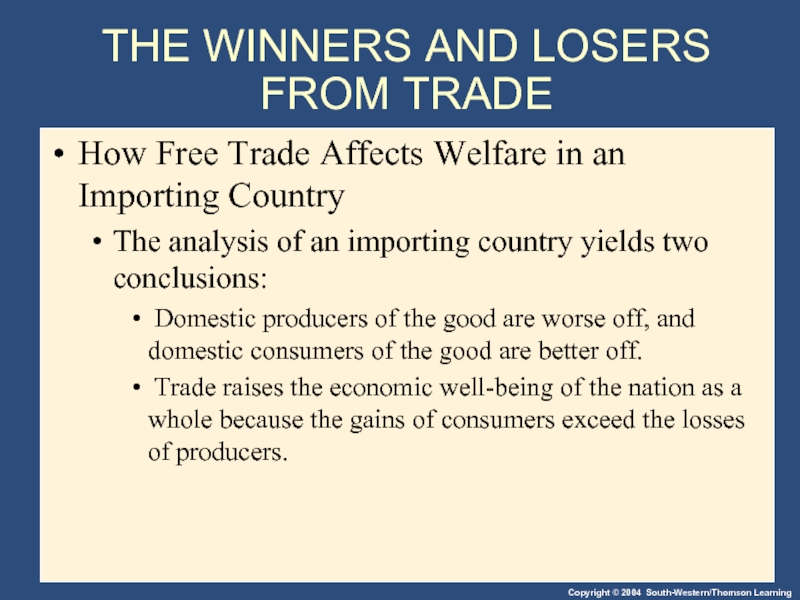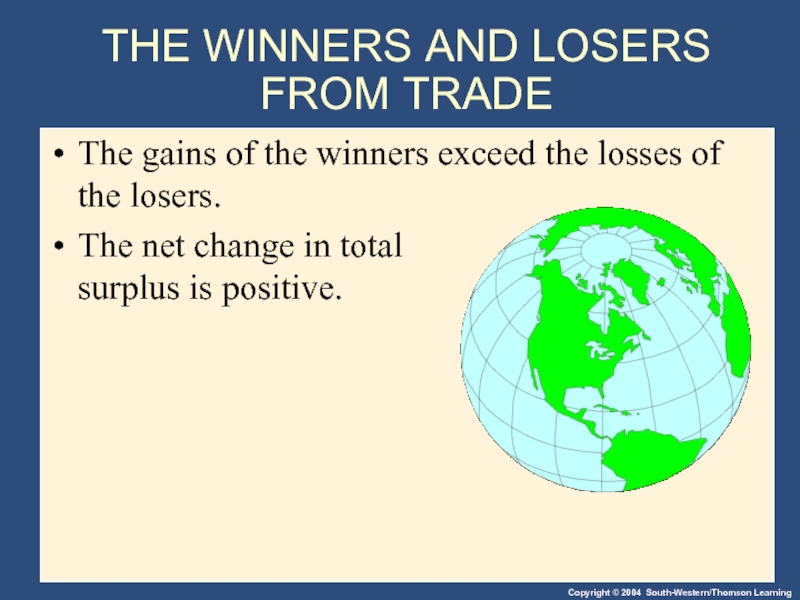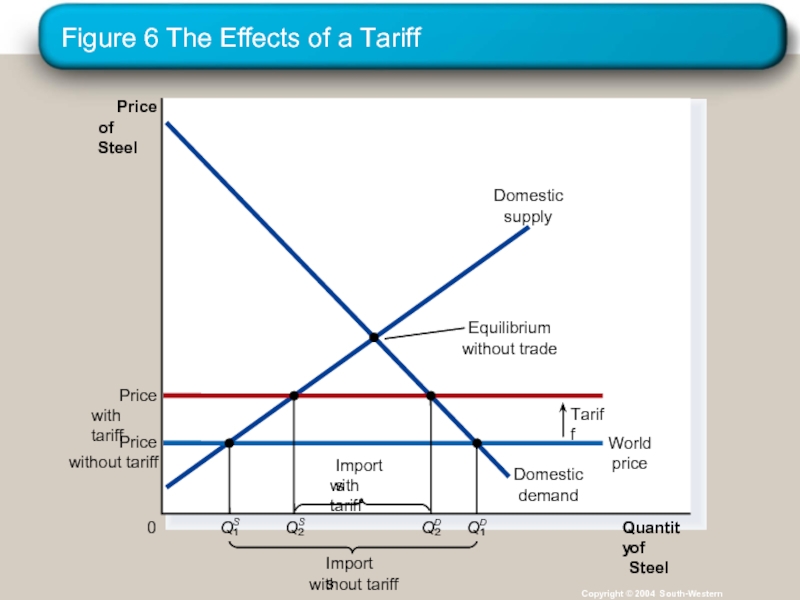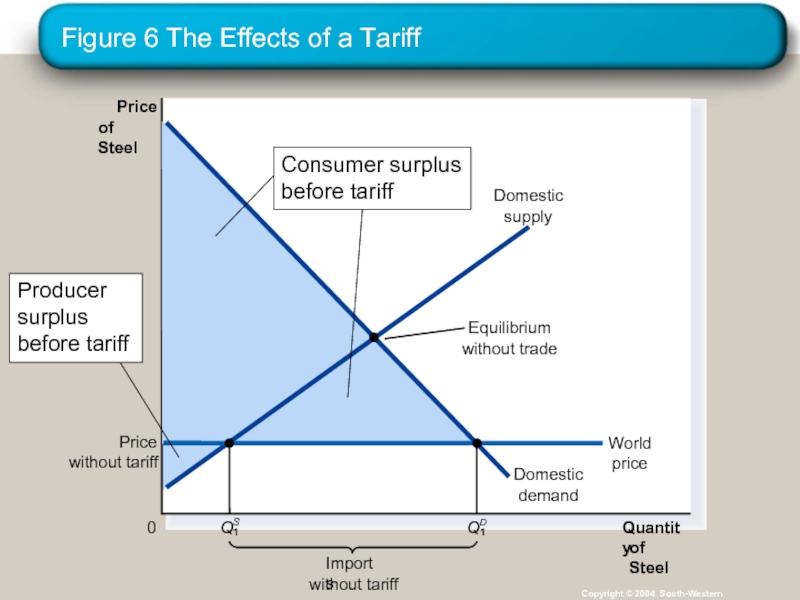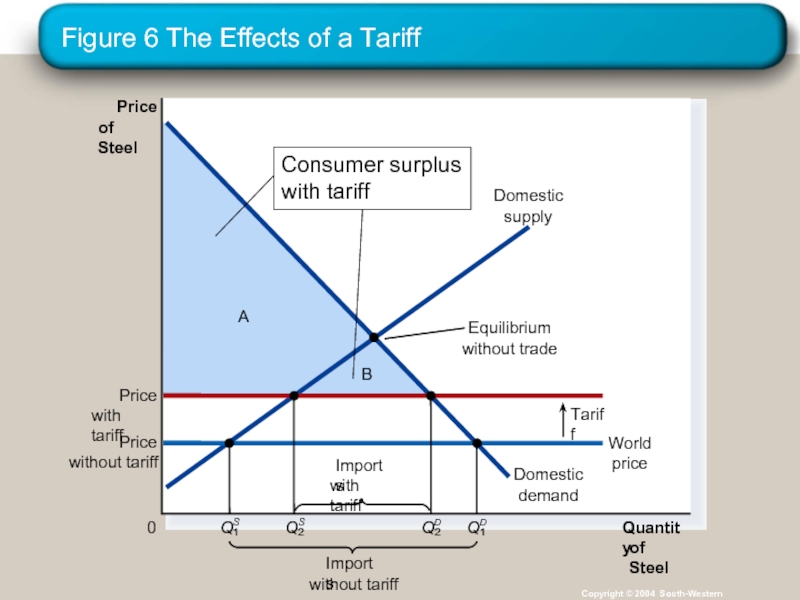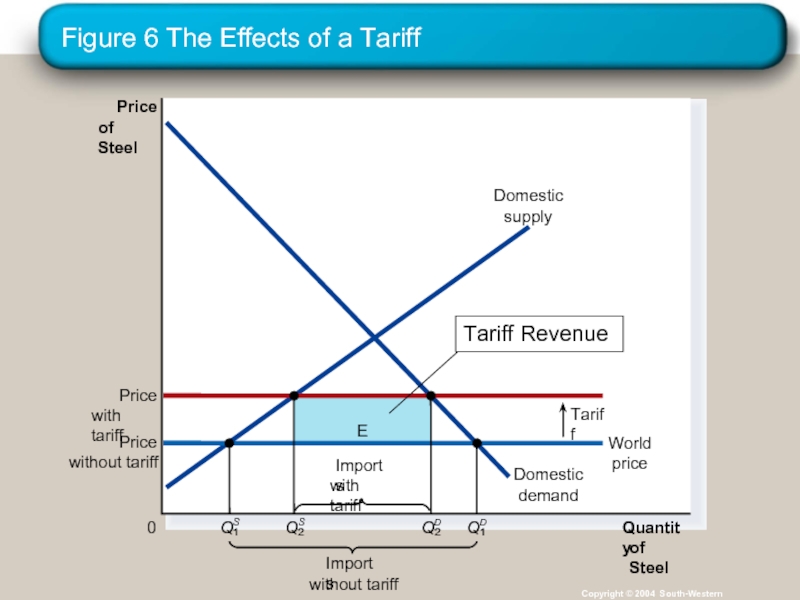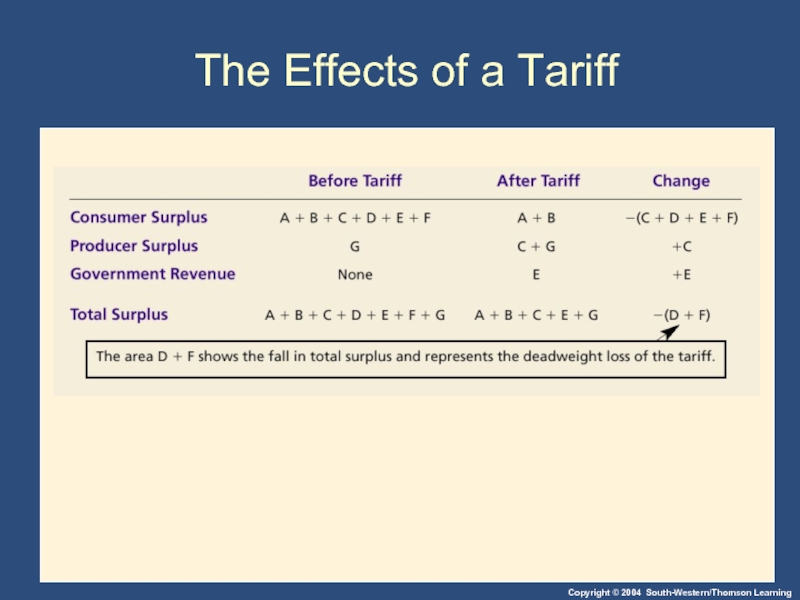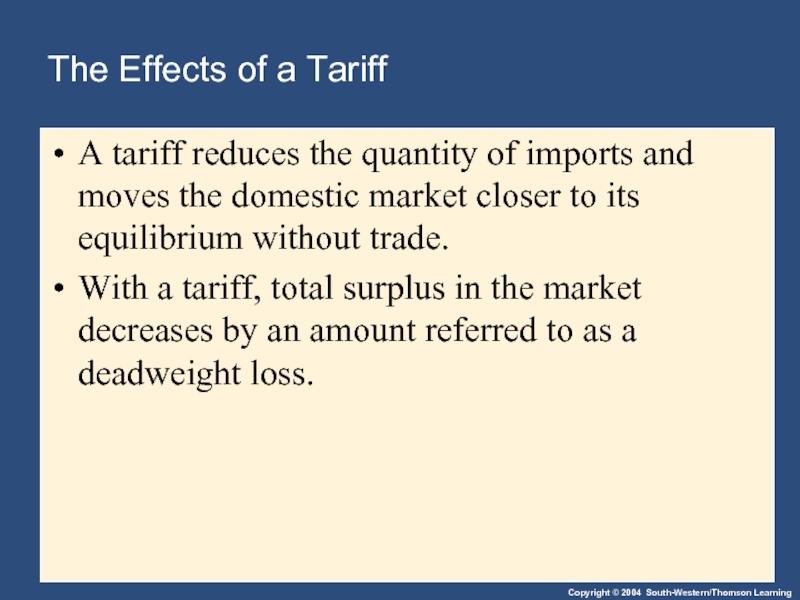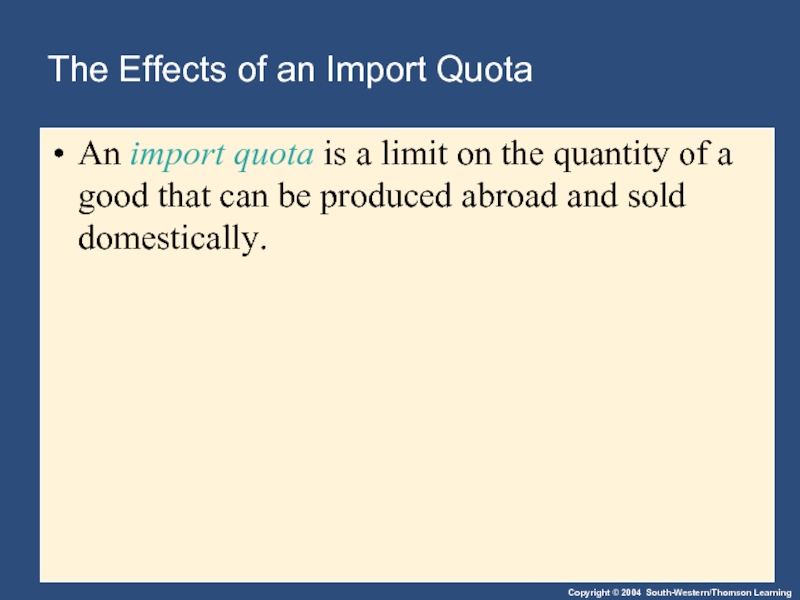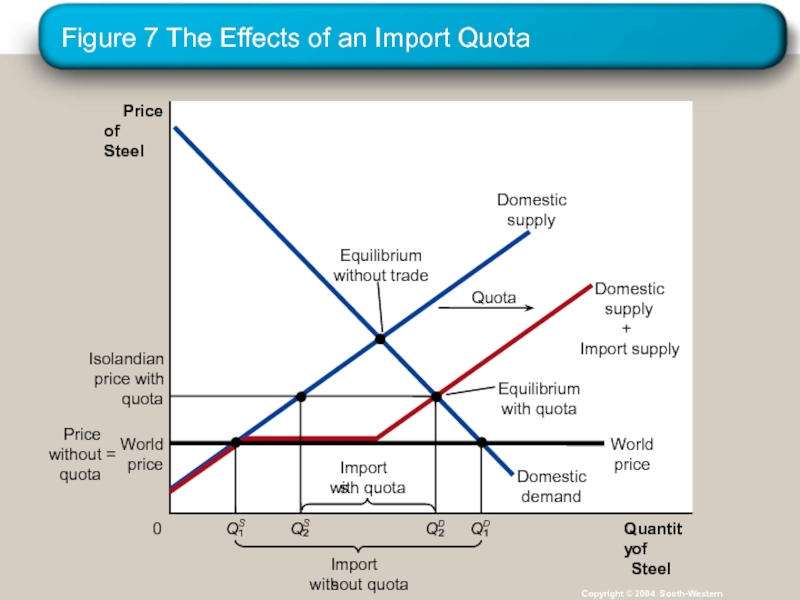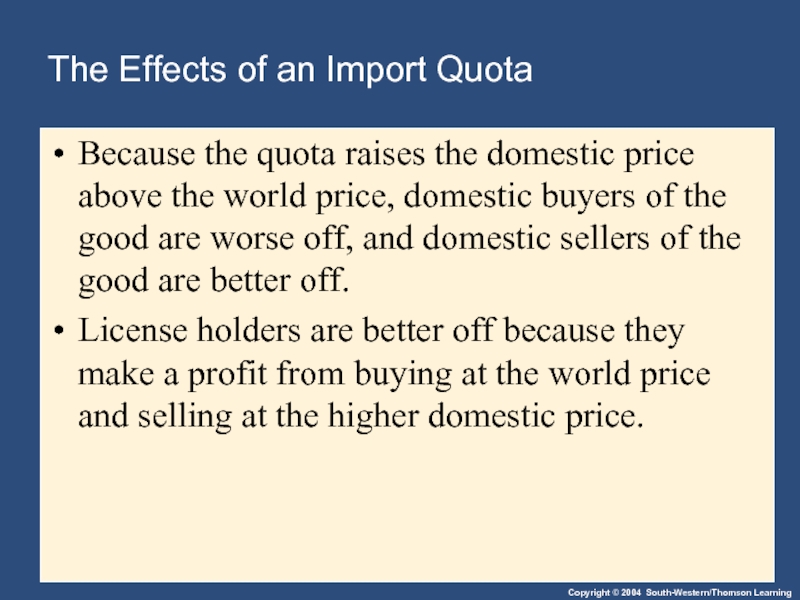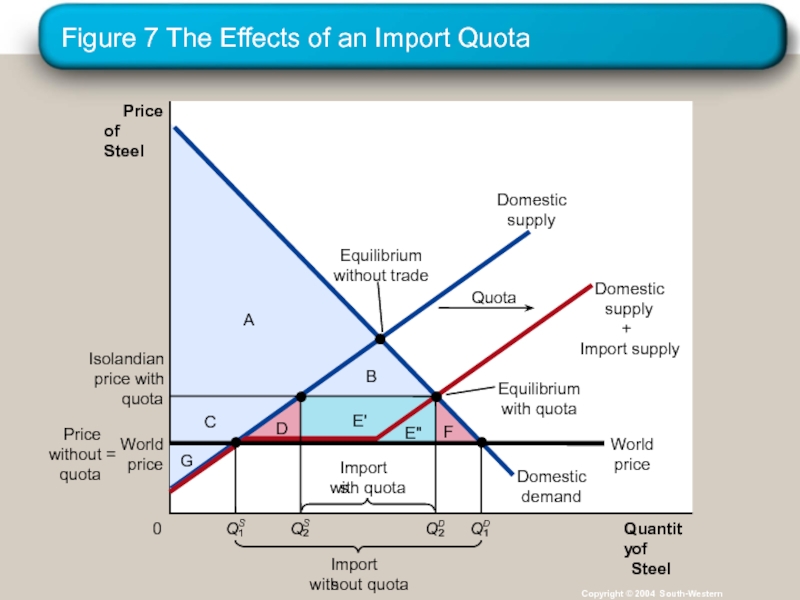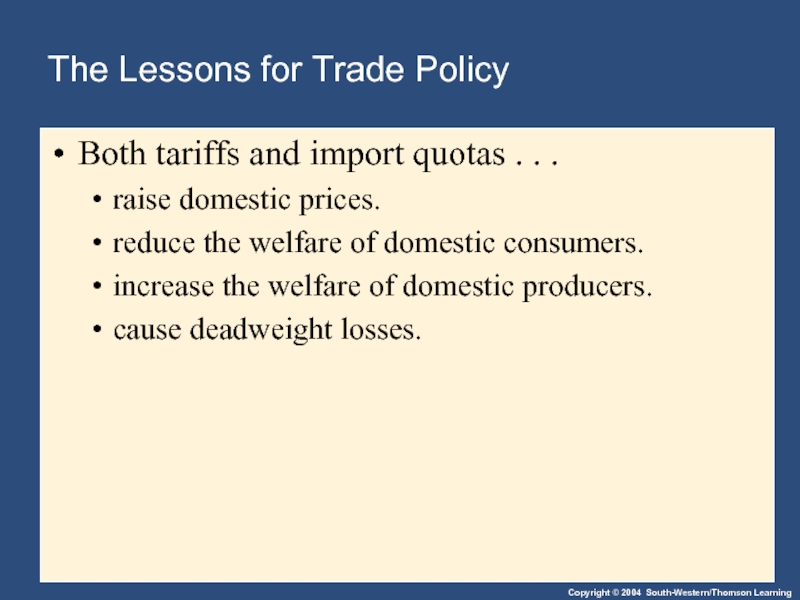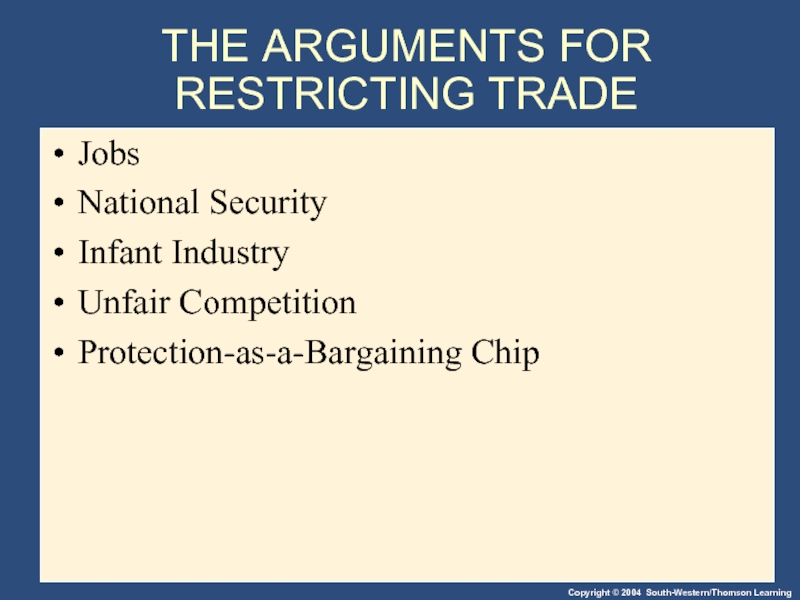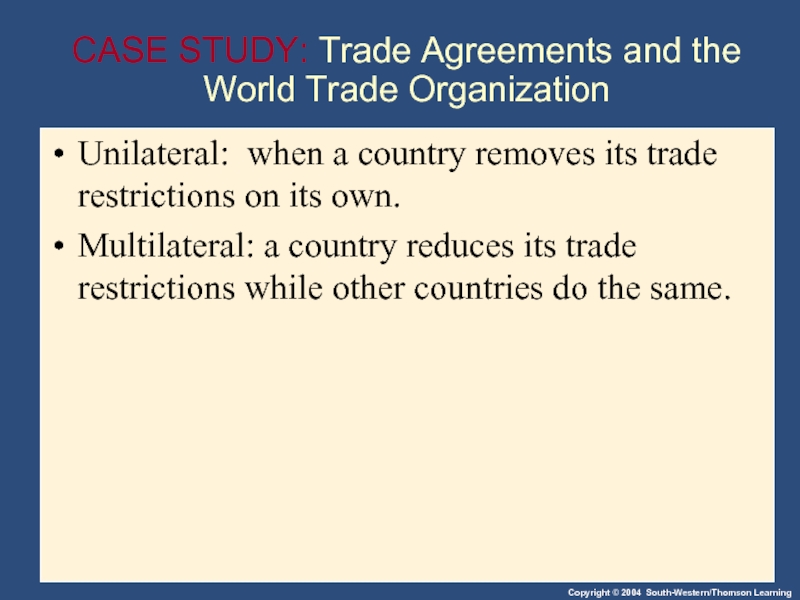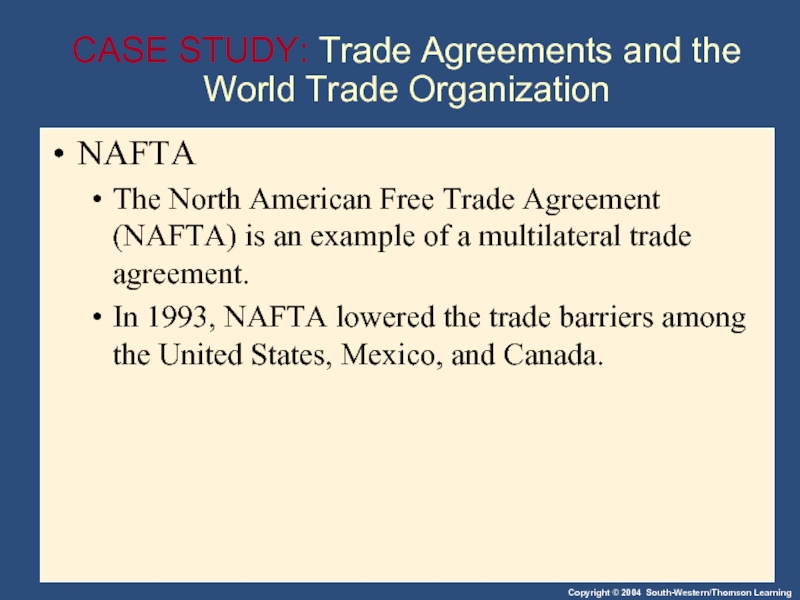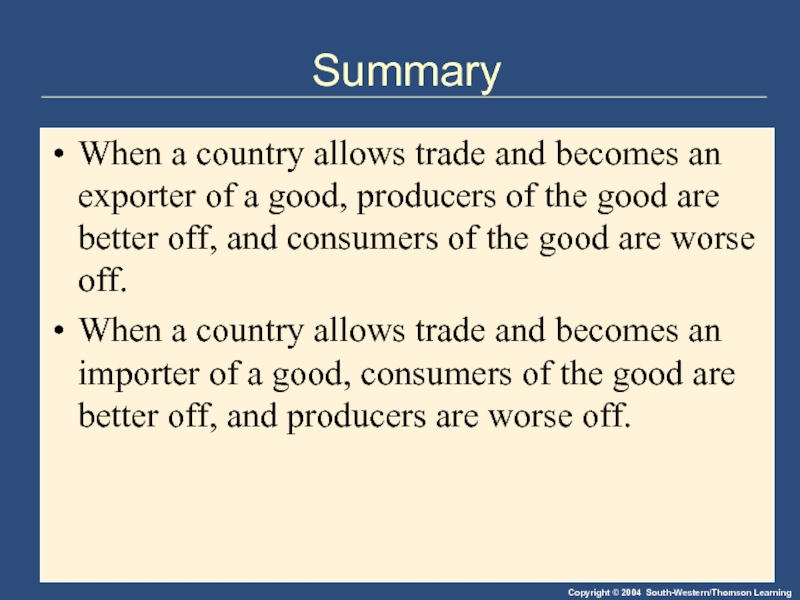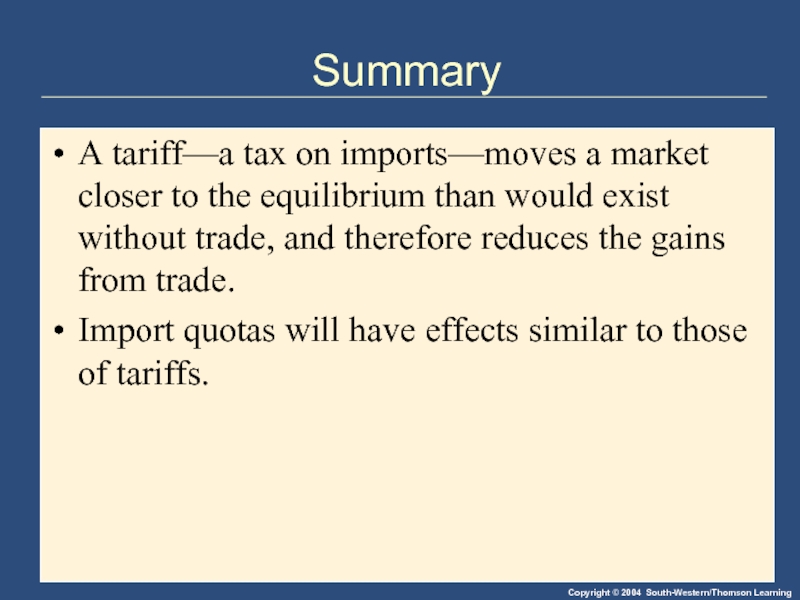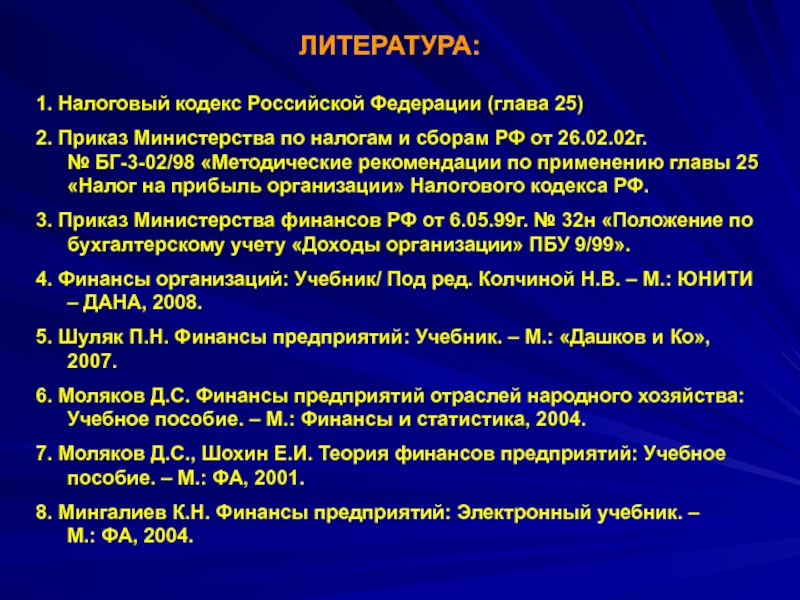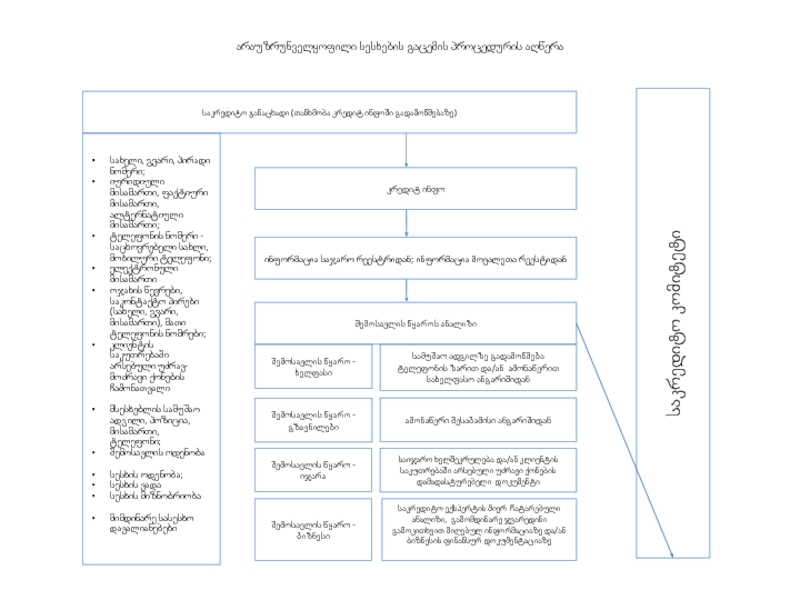- Главная
- Разное
- Дизайн
- Бизнес и предпринимательство
- Аналитика
- Образование
- Развлечения
- Красота и здоровье
- Финансы
- Государство
- Путешествия
- Спорт
- Недвижимость
- Армия
- Графика
- Культурология
- Еда и кулинария
- Лингвистика
- Английский язык
- Астрономия
- Алгебра
- Биология
- География
- Детские презентации
- Информатика
- История
- Литература
- Маркетинг
- Математика
- Медицина
- Менеджмент
- Музыка
- МХК
- Немецкий язык
- ОБЖ
- Обществознание
- Окружающий мир
- Педагогика
- Русский язык
- Технология
- Физика
- Философия
- Химия
- Шаблоны, картинки для презентаций
- Экология
- Экономика
- Юриспруденция
Application International Trade. What determines whether a country imports or exports a good презентация
Содержание
- 1. Application International Trade. What determines whether a country imports or exports a good
- 2. What determines whether a country imports or exports a good?
- 3. Who gains and who loses from free trade among countries?
- 4. What are the arguments that people use to advocate trade restrictions?
- 5. THE DETERMINANTS OF TRADE Equilibrium Without Trade
- 6. Figure 1The Equilibrium without International Trade Copyright
- 7. The Equilibrium Without International Trade Equilibrium Without
- 8. The World Price and Comparative Advantage If
- 9. The World Price and Comparative Advantage The
- 10. The World Price and Comparative Advantage
- 11. The World Price and Comparative Advantage If
- 12. Figure 2 International Trade in an Exporting
- 13. Figure 3 How Free Trade Affects Welfare
- 14. Figure 3 How Free Trade Affects Welfare
- 15. How Free Trade Affects Welfare in an Exporting Country
- 16. THE WINNERS AND LOSERS FROM TRADE The
- 17. The Gains and Losses of an Importing
- 18. Figure 4 International Trade in an Importing
- 19. Figure 5 How Free Trade Affects Welfare
- 20. Figure 5 How Free Trade Affects Welfare
- 21. Figure 5 How Free Trade Affects Welfare
- 22. How Free Trade Affects Welfare in an Importing Country
- 23. THE WINNERS AND LOSERS FROM TRADE
- 24. THE WINNERS AND LOSERS FROM TRADE The
- 25. The Effects of a Tariff A tariff
- 26. Figure 6 The Effects of a Tariff
- 27. Figure 6 The Effects of a Tariff
- 28. Figure 6 The Effects of a Tariff
- 29. Figure 6 The Effects of a Tariff
- 30. Figure 6 The Effects of a Tariff
- 31. Figure 6 The Effects of a Tariff
- 32. The Effects of a Tariff
- 33. The Effects of a Tariff A tariff
- 34. The Effects of an Import Quota An
- 35. Figure 7 The Effects of an Import
- 36. The Effects of an Import Quota Because
- 37. Figure 7 The Effects of an Import
- 38. The Effects of an Import Quota
- 39. The Effects of an Import Quota With
- 40. The Lessons for Trade Policy If government
- 41. The Lessons for Trade Policy Both
- 42. The Lessons for Trade Policy Other
- 43. THE ARGUMENTS FOR RESTRICTING TRADE Jobs
- 44. CASE STUDY: Trade Agreements and the World
- 45. CASE STUDY: Trade Agreements and the World
- 46. CASE STUDY: Trade Agreements and the World
- 47. Summary The effects of free trade can
- 48. Summary When a country allows trade and
- 49. Summary A tariff—a tax on imports—moves a
- 50. Summary There are various arguments for restricting
Слайд 5THE DETERMINANTS OF TRADE
Equilibrium Without Trade
Assume:
A country is isolated from rest
The market for steel consists of the buyers and sellers in the country.
No one in the country is allowed to import or export steel.
Слайд 6Figure 1The Equilibrium without International Trade
Copyright © 2004 South-Western
Price
of Steel
0
Quantity
of Steel
Слайд 7The Equilibrium Without International Trade
Equilibrium Without Trade
Results:
Domestic price adjusts to
The sum of consumer and producer surplus measures the total benefits that buyers and sellers receive.
Слайд 8The World Price and Comparative Advantage
If the country decides to engage
Слайд 9The World Price and Comparative Advantage
The effects of free trade can
Слайд 10The World Price and Comparative Advantage
If a country has a
Слайд 11The World Price and Comparative Advantage
If the country does not have
Слайд 12Figure 2 International Trade in an Exporting Country
Copyright © 2004 South-Western
Price
of
0
Quantity
of Steel
Слайд 13Figure 3 How Free Trade Affects Welfare in an Exporting Country
Copyright
Price
of Steel
0
Quantity
of Steel
Слайд 14Figure 3 How Free Trade Affects Welfare in an Exporting Country
Copyright
Price
of Steel
0
Quantity
of Steel
Слайд 16THE WINNERS AND LOSERS FROM TRADE
The analysis of an exporting country
Domestic producers of the good are better off, and domestic consumers of the good are worse off.
Trade raises the economic well-being of the nation as a whole.
Слайд 17The Gains and Losses of an Importing Country
International Trade in
If the world price of steel is lower than the domestic price, the country will be an importer of steel when trade is permitted.
Domestic consumers will want to buy steel at the lower world price.
Domestic producers of steel will have to lower their output because the domestic price moves to the world price.
Слайд 18Figure 4 International Trade in an Importing Country
Copyright © 2004 South-Western
Price
of
0
Quantity
of Steel
Слайд 19Figure 5 How Free Trade Affects Welfare in an Importing Country
Copyright
Price
of Steel
0
Quantity
of Steel
Слайд 20Figure 5 How Free Trade Affects Welfare in an Importing Country
Copyright
Price
of Steel
0
Quantity
of Steel
Слайд 21Figure 5 How Free Trade Affects Welfare in an Importing Country
Copyright
Price
of Steel
0
Quantity
of Steel
Слайд 23THE WINNERS AND LOSERS FROM TRADE
How Free Trade Affects Welfare
The analysis of an importing country yields two conclusions:
Domestic producers of the good are worse off, and domestic consumers of the good are better off.
Trade raises the economic well-being of the nation as a whole because the gains of consumers exceed the losses of producers.
Слайд 24THE WINNERS AND LOSERS FROM TRADE
The gains of the winners exceed
The net change in total surplus is positive.
Слайд 25The Effects of a Tariff
A tariff is a tax on goods
Tariffs raise the price of imported goods above the world price by the amount of the tariff.
Слайд 26Figure 6 The Effects of a Tariff
Copyright © 2004 South-Western
Price
of Steel
0
Quantity
of
Tariff
Слайд 27Figure 6 The Effects of a Tariff
Copyright © 2004 South-Western
Price
of Steel
0
Quantity
of
Слайд 28Figure 6 The Effects of a Tariff
Copyright © 2004 South-Western
Price
of Steel
0
Quantity
of
Tariff
Слайд 29Figure 6 The Effects of a Tariff
Copyright © 2004 South-Western
Price
of Steel
0
Quantity
of
Tariff
Слайд 30Figure 6 The Effects of a Tariff
Copyright © 2004 South-Western
Price
of Steel
0
Quantity
of
Tariff
World
price
Слайд 31Figure 6 The Effects of a Tariff
Copyright © 2004 South-Western
Price
of Steel
0
Quantity
of
Tariff
World
price
Слайд 33The Effects of a Tariff
A tariff reduces the quantity of imports
With a tariff, total surplus in the market decreases by an amount referred to as a deadweight loss.
Слайд 34The Effects of an Import Quota
An import quota is a limit
Слайд 35Figure 7 The Effects of an Import Quota
Copyright © 2004 South-Western
Price
of
0
Quantity
of Steel
Quota
Слайд 36The Effects of an Import Quota
Because the quota raises the domestic
License holders are better off because they make a profit from buying at the world price and selling at the higher domestic price.
Слайд 37Figure 7 The Effects of an Import Quota
Copyright © 2004 South-Western
E"
Price
of
0
Quantity
of Steel
Quota
Слайд 39The Effects of an Import Quota
With a quota, total surplus in
The quota can potentially cause an even larger deadweight loss, if a mechanism such as lobbying is employed to allocate the import licenses.
Слайд 40The Lessons for Trade Policy
If government sells import licenses for full
Слайд 41The Lessons for Trade Policy
Both tariffs and import quotas .
raise domestic prices.
reduce the welfare of domestic consumers.
increase the welfare of domestic producers.
cause deadweight losses.
Слайд 42The Lessons for Trade Policy
Other Benefits of International Trade
Increased variety
Lower costs through economies of scale
Increased competition
Enhanced flow of ideas
Слайд 43THE ARGUMENTS FOR RESTRICTING TRADE
Jobs
National Security
Infant Industry
Unfair Competition
Protection-as-a-Bargaining Chip
Слайд 44CASE STUDY: Trade Agreements and the World Trade Organization
Unilateral: when a
Multilateral: a country reduces its trade restrictions while other countries do the same.
Слайд 45CASE STUDY: Trade Agreements and the World Trade Organization
NAFTA
The North American
In 1993, NAFTA lowered the trade barriers among the United States, Mexico, and Canada.
Слайд 46CASE STUDY: Trade Agreements and the World Trade Organization
GATT
The General Agreement
GATT has successfully reduced the average tariff among member countries from about 40 percent after WWII to about 5 percent today.
Слайд 47Summary
The effects of free trade can be determined by comparing the
A low domestic price indicates that the country has a comparative advantage in producing the good and that the country will become an exporter.
A high domestic price indicates that the rest of the world has a comparative advantage in producing the good and that the country will become an importer.
Слайд 48Summary
When a country allows trade and becomes an exporter of a
When a country allows trade and becomes an importer of a good, consumers of the good are better off, and producers are worse off.
Слайд 49Summary
A tariff—a tax on imports—moves a market closer to the equilibrium
Import quotas will have effects similar to those of tariffs.
Слайд 50Summary
There are various arguments for restricting trade: protecting jobs, defending national
Economists, however, believe that free trade is usually the better policy.
